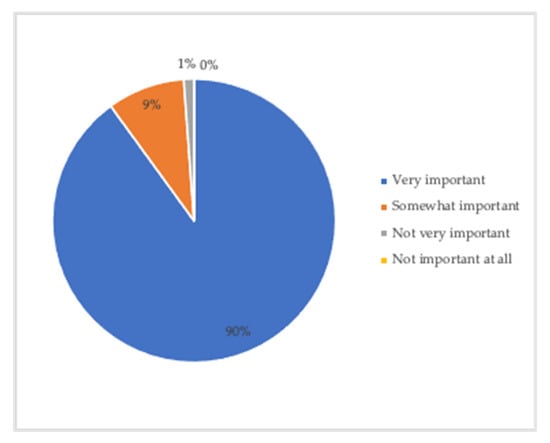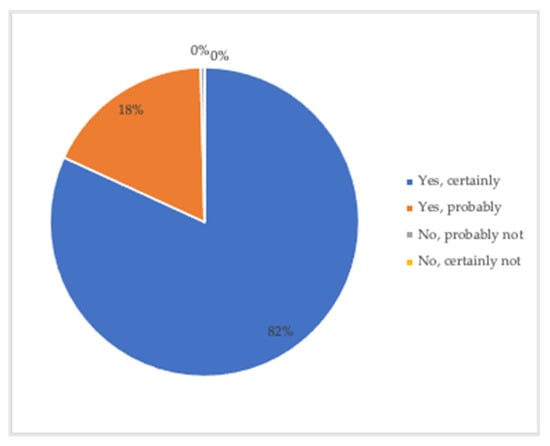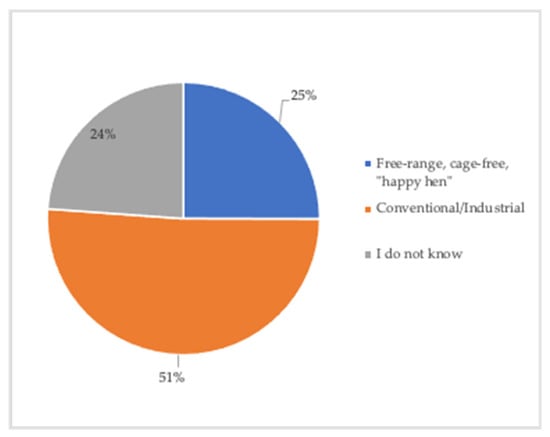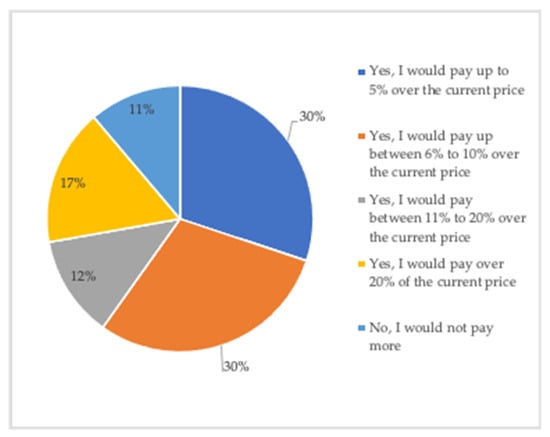Abstract
We investigated the current knowledge of animal welfare issues, the perception of current welfare of laying hens, and the willingness-to-pay in consumers in Santiago, the main city and capital of Chile. Most people were well educated in animal welfare concepts, and declared that the welfare of laying hens is very important and should be protected, and were willing to pay between 5% and 10% of current value for eggs produced in welfare-friendly systems. Our results show a clear predisposition for choosing products derived from animal production systems that respect animal welfare, which should be considered for the sustainability of egg production in Chile.
1. Introduction
The welfare of laying hens has been the subject of interest in consumers, industry, and the government in Chile. The current main egg production system in Chile is the intensive cage system [1], allowing high egg production (3.9 thousand million in 2019) for an increasing human population. Joint efforts have been carried out between the industry, universities, and the government to establish minimum welfare conditions, including the development of the Good Welfare Practices for Laying Hen Production [2]. Cage-free, free-range, and “happy hens” eggs are commercially available and consumption is increasing rapidly in Chile [3]. Several studies have shown that public perception is that animals in free-range or cage-free egg production systems have better animal welfare than those in more intensive systems [4,5]. Some studies have shown that cage-free or free-range hens may be subjected to poorer welfare and health [6,7,8,9]. Also, in an increasing global human population, cage-free or free-range production systems seem unsustainable [10,11]. We conducted a study to measure the current perception of consumers in Santiago, Chile, on the welfare of hens for egg production and the willingness-to-pay for products originating from cage-free or free-range systems.
2. Materials and Methods
A combination of person-to-person and online application of questionnaires was carried out in Santiago, Chile, based on the European Food Safety Agency’s questionnaire on the attitudes of EU citizens towards animal welfare [12]. Briefly, the questionnaire consisted of 27 closed-ended questions divided into three conceptual groups. The first set of questions were aimed to measured general animal welfare knowledge, the second set of questions where aimed to measured poultry welfare, while the third group consisted of questions related to the willingness-to-pay for eggs produced under either standard (industrial), cage-free or free-range production systems. The target population was any person between 18 and 59 years old with permanent residency in Santiago. This target population was estimated to be 3,553,067 people based on the latest census. No other inclusion or exclusion criteria was applied. A sample size of 262 persons was established, with a 95% confidence level and a 6% confidence interval. No personal or confidential data were obtained. All national and institutional ethical recommendations and guidelines were followed in order to preserve ethical integrity during the study. Descriptive statistical analysis was carried out for each question and Spearman rank test was carried out to find any correlation between variables.
3. Results
Over 98% of people recognized animal welfare as something somewhat important to very important and described the welfare of hens as a “very important” issue (89.9%, Figure 1). Almost all people (99.6%, Figure 2) declared that welfare should be protected. Welfare concepts were described as “conditions that human have to provide to animals to give a good quality of life” (41%), “involves more than animal protection laws” (33%), and “the duty to respect the life of all animals” (29%). Also, 82% of consumer believed that “educating children about welfare can have a very good influence on how to treat other animals”. Most consumers were interested in obtaining more information about the welfare of production animals (89.9%).

Figure 1.
Distribution (%) of answers concerning the importance of welfare of hens in Santiago, Chile (n = 262).

Figure 2.
Distribution (%) of answers related to the desired level of animal welfare protection in hens in Santiago, Chile (n = 262).
Egg consumption was high, with 48.2% of consumers eating more than three eggs each week. Interestingly, 25% of the consumers bought cage-free or free-range eggs, with 51% buying traditional/industrial eggs and 24% not knowing the origin of the eggs they bought (Figure 3). Willingness-to-pay for welfare-friendly eggs was high, with 17% of consumers willing to pay more than 20% over the normal value, 12% of consumers willing to pay between 11% and 20% over normal value, 30% of consumers willing to pay between 6% to 10% over the normal value, 30% of consumers willing to pay up to 5% over current value, and only 11% of consumers stating that they would not pay more for welfare-friendly eggs (Figure 4).

Figure 3.
Distribution (%) of the origin of eggs bought by consumers in in Santiago, Chile (n = 262).

Figure 4.
Distribution (%) of the degree of willingness-to-pay for eggs produced under welfare-friendly conditions of consumers in Santiago, Chile (n = 262).
4. Discussion
Results showed that consumers in the capital city of Chile have a relatively good knowledge of welfare concepts and are concerned about the welfare of laying hens. This is in agreement with other studies in Europe and United States [13], showing an increasing interest even in developing countries. The consumers in Santiago were willing to pay more for apparently welfare-friendly eggs, such as those derived from free-range and cage-free hens. This is similar to results in European countries [4,11] or Mexico [14]. Interestingly, the current scientific evidence seems to point out that free-range or cage-free production systems impose a greater welfare risk (diseases, environmental threats) than those utilizing cages and more intensified systems [6,15]. There have been increasing reports of outbreaks of food transmitted diseases, such as salmonellosis, related to the consumption of eggs from free-range or cage-free systems [16,17]. Additionally, in order to provide eggs in a sustainable way (energy, water, and land use) for an increasing human population, intensive systems should be used. Future studies should explore the future of free-range or cage-free systems, considering the higher risk for welfare and sustainability [11,18]. This work is the first to taken on these issues and may reflect the current higher interest in Chilean consumers. Welfare issues should be considered in the future to achieved a good sustainable production of eggs in Chile and other developing or developed countries.
Author Contributions
Conceptualization, N.M. and H.C.-J.; methodology, H.C.-J.; formal analysis, N.M. and H.C.-J.; investigation, N.M.; data curation, H.C.-J.; writing—original draft preparation, N.M., C.U. and H.C.-J.; writing—review and editing, C.U. and H.C.-J.; supervision, C.U. and H.C.-J. All authors have read and agreed to the published version of the manuscript.
Funding
This research received no external funding.
Institutional Review Board Statement
Ethical review and approval were waived for this study, due to study design which collected no personal critical information.
Informed Consent Statement
Informed consent was obtained from all subjects involved in the study.
Conflicts of Interest
The authors declare no conflict of interest.
References
- ODEPA Estadísticas Productivas-ODEPA-Ministerio de Agricultura de Chile. Available online: http://www.odepa.cl/estadisticas/productivas/ (accessed on 28 June 2017).
- Servicio Agrícola y Ganadero. Guía de Buenas Practicas sobre Bienestar Animal en los diferentes Sistemas de Produccion de Huevos; Servicio Agrícola y Ganadero: Santiago, Chile, 2018; 48p.
- Michels, P.M. Producción de huevos de “gallinas felices” se dispara 100% en el último año y se abre debate en torno a la certificación. El Mercurio 2019. [Google Scholar]
- Vanhonacker, F.; Verbeke, W. Buying higher welfare poultry products? Profiling Flemish consumers who do and do not. Poult. Sci. 2009, 88, 2702–2711. [Google Scholar] [CrossRef] [PubMed]
- Pettersson, I.C.; Weeks, C.A.; Wilson, L.R.M.; Nicol, C.J. Consumer perceptions of free-range laying hen welfare. Br. Food J. 2016, 118, 1999–2013. [Google Scholar] [CrossRef]
- Campbell, D.L.M.; Bari, M.S.; Rault, J.-L. Free-range egg production: Its implications for hen welfare. Anim. Prod. Sci. 2020. [Google Scholar] [CrossRef]
- Lambton, S.; Knowles, T.; Yorke, C.; Nicol, C. The risk factors affecting the development of vent pecking and cannibalism in free-range and organic laying hens. Anim. Welf. 2015, 24, 101–111. [Google Scholar] [CrossRef]
- Bestman, M.; Bikker-Ouwejan, J. Predation in Organic and Free-Range Egg Production. Animals 2020, 10, 177. [Google Scholar] [CrossRef]
- Sherwin, C.M.; Nasr, M.A.F.; Gale, E.; Petek, M.; Stafford, K.; Turp, M.; Coles, G.C. Prevalence of nematode infection and faecal egg counts in free-range laying hens: Relations to housing and husbandry. Br. Poult. Sci. 2013, 54, 12–23. [Google Scholar] [CrossRef]
- Molnár, S.; Szőllősi, L. Sustainability and Quality Aspects of Different Table Egg Production Systems: A Literature Review. Sustainability 2020, 12, 7884. [Google Scholar] [CrossRef]
- Rondoni, A.; Asioli, D.; Millan, E. Consumer behaviour, perceptions, and preferences towards eggs: A review of the literature and discussion of industry implications. Trends Food Sci. Technol. 2020, 106, 391–401. [Google Scholar] [CrossRef]
- EFSA. Attitudes of EU Citizens towards Animal Welfare; Special Eurobarometer 270/Wave 66.1-TNS Opinion & Social; European Commission: Brussels, Belgium, 2007; Volume 82.
- Alonso, M.E.; González-Montaña, J.R.; Lomillos, J.M. Consumers’ Concerns and Perceptions of Farm Animal Welfare. Animals 2020, 10, 385. [Google Scholar] [CrossRef] [PubMed]
- Miranda-de la Lama, G.C.; Estévez-Moreno, L.X.; Villarroel, M.; Rayas-Amor, A.A.; María, G.A.; Sepúlveda, W.S. Consumer Attitudes Toward Animal Welfare-Friendly Products and Willingness to Pay: Exploration of Mexican Market Segments. J. Appl. Anim. Welf. Sci. 2019, 22, 13–25. [Google Scholar] [CrossRef]
- Bestman, M.; Verwer, C.; van Niekerk, T.; Leenstra, F.; Reuvekamp, B.; Amsler-Kepalaite, Z.; Maurer, V. Factors related to free-range use in commercial laying hens. Appl. Anim. Behav. Sci. 2019, 214, 57–63. [Google Scholar] [CrossRef]
- Kenny, B.; Miller, M.J.; McEvoy, V.; Centofanti, A.; Stevens, C.P. A protracted outbreak of Salmonella Hessarek infection associated with one brand of eggs—South Australia, March 2017–July 2018. Commun. Dis. Intell. 2019, 43. [Google Scholar] [CrossRef] [PubMed]
- Sloan-Gardner, T.S.; Waters, N.; Marmor, A.; Mude, W. Free range eggs does not mean safe eggs: An outbreak of Salmonella Typhimurium linked to free range eggs. Commun. Dis. Intell. 2019, 43. [Google Scholar] [CrossRef] [PubMed]
- Andersen, L.M. Animal Welfare and Eggs-Cheap Talk or Money on the Counter? J. Agric. Econ. 2011, 62, 565–584. [Google Scholar] [CrossRef]
Publisher’s Note: MDPI stays neutral with regard to jurisdictional claims in published maps and institutional affiliations. |
© 2020 by the authors. Licensee MDPI, Basel, Switzerland. This article is an open access article distributed under the terms and conditions of the Creative Commons Attribution (CC BY) license (https://creativecommons.org/licenses/by/4.0/).